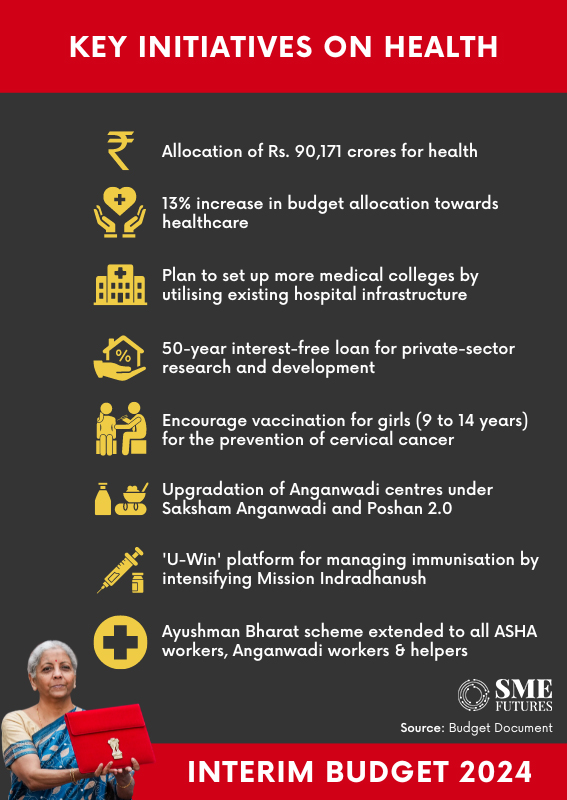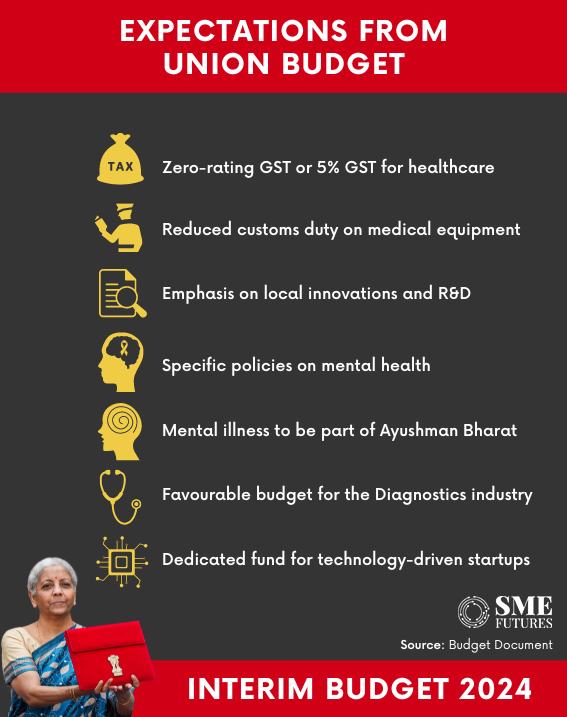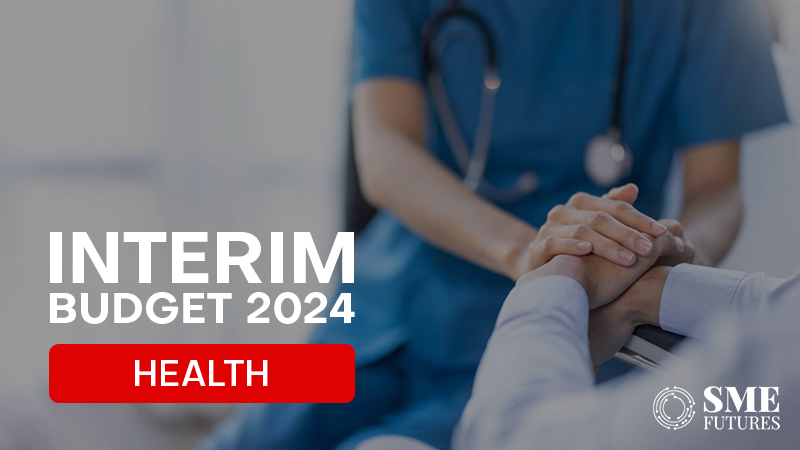This year’s interim budget covered several critical topics of health and healthcare measures targeted at increasing the well-being of the Indian population.
The finance minister emphasised the government’s commitment towards inclusive development and progress. The primary goal is to improve healthcare services and access to medical facilities for all citizens, while meeting the population’s different health demands.
Currently, the health ministry has been allocated ₹ 90,658.63 crores in this interim budget, a hike of 12.59 per cent over Rs 80,517.62 crores in the previous budget (revised estimates). The Ministry for Women and Child Development (WCD) has been allotted ₹26,092 crores, 2.53 per cent higher than FY24.
Dr Rajeev Boudhankar, Medical Director, Holy Family Hospital, Bandra, says, “The 13 per cent increase in budget allocation towards healthcare is a promising move and will help our country to take a more positive direction towards the goal of universal healthcare.”
Empowering medical education and services
One of the most significant healthcare announcements is about opening more medical colleges using existing hospital infrastructure, to meet the growing aspirations of young people to become certified doctors and serve their communities through enhanced healthcare services.
Furthermore, the proposal to establish a committee to examine issues and make relevant recommendations reflects a strategic approach towards addressing the evolving medical education landscape and healthcare infrastructure.
Dr. Sudhir Srivastava, Founder, Chairman & CEO, SS Innovations, says, “Committees can assess the current hospital medical infrastructure in comparison to emerging and futuristic technologies like robotics, artificial intelligence, and remote medical services that can be introduced for the benefit of patients and enable medical students to learn new technologies.”
Krutikesh Age, Co-founder, DPHS Pvt. Ltd, comments, “For the healthcare industry, the expansion of medical colleges contributes to skill development and technological advancements. Yet, financial pressures and regulatory compliance pose significant hurdles. Competition among providers may increase, potentially driving consolidation and limiting options for consumers.”
Promoting preventive healthcare – Cervical cancer vaccination
The government’s emphasis on preventative healthcare is evident from its proposal to push cervical cancer immunisation for females aged 9 to 14 years.
Dr. Devavrat Arya, Senior Director, Max Hospital, Saket, says, “This age range is perfectly suitable because it offers the best protection before girls become sexually active, when they are most susceptible to HPV infection.”
Tejinder Pal Singh, Senior Partner – Pharma, Healthcare & Life Sciences feels that this step will strengthen our global reach, address unmet health needs and reduce the high disease burden.
Nishant Mishra, Chief Marketing Officer, Apollo Health and Lifestyle Limited, says, “Out of all HPV viruses, HPV 16 and 18 are the most predominant types which cause cervical cancer. All people aged 9 to 45 can get the HPV vaccine to protect against genital warts and HPV-related cancer.” By focusing on preventive measures, the government aims to address critical health issues at an early stage, thereby safeguarding the well-being of the population.
Krunal Mehta, Co-founder & COO, Jivika Healthcare, says, “The emphasis on cervical cancer vaccination will alleviate the burden on the government’s healthcare system, potentially lowering mortality rates. This initiative aligns seamlessly with Jivika Healthcare’s mission of ‘Cervical Cancer Mukt Bharat.’”

Enhancing maternal and child healthcare
The budget also outlined plans to streamline various maternal and childcare schemes under a comprehensive programme. This move is designed to ensure synergy in implementing maternal and child healthcare initiatives, thereby optimising the impact of these essential services for the well-being of mothers and children.
Dr Kshitiz Murdia, CEO & Co-Founder, Indira IVF, says, “The latest National Family Health Survey-V of 2019-21 has called attention to numerous parameters that have reached concerning levels. This includes the total fertility rate (or children per woman) which is at an alarming replacement level of 2.0. The move to expedite the action through Saksham Aganwadi for the benefit of mother and child is an imperative step to improve the health parameters of the rural population.”
Furthermore, the expedited upgradation of Anganwadi centres under Saksham Anganwadi and Poshan 2.0 demonstrates a concerted effort to enhance nutrition delivery, early childhood care, and development.
Anish Bafna, CEO and MD, Healthium Medtech, says, “Poshan 2.0 and increased penetration under the Ayushman Bharat scheme will go a long way to improve and aid nutrition delivery, early childhood care, and development in rural last-mile communities. However, pragmatic guidelines are still required to prioritize the adoption of the latest technologies for better clinical outcomes and improving patient centricity.”
Intensifying healthcare delivery
The FM also emphasised the need for hastening the rollout of the newly developed U WIN platform for managing immunisations, as well as the intensification of Mission Indradhanush across the country. This demonstrates the government’s commitment towards providing effective healthcare services and immunisation programmes, particularly in neglected areas.
Jasdeep Singh, Group CEO, CARE Hospitals Group, says, “The ‘U-Win’ platform for managing immunisation, along with the intensification of Mission Indradhanush, will be rapidly implemented across the country. The government’s multifaceted approach in this budget underscores a dedication to quality healthcare, particularly in tier II cities and rural regions.”
Dr. Vivek Desai, Founder & Managing Director of HOSMAC (Asia’s leading hospital planning, design and management consultancy), says, “Healthcare infrastructure will also see indirect benefits from Gati Shakti that enables multi-modal connectivity, by improving supply chain management and reducing overall costs.”
Gaurav Srivastava, Co-Founder & COO, HaystackAnalytics, says, “With a revised fiscal deficit estimated at 5.8 per cent of GDP, the government’s strategic resource allocation will hopefully enhance the future of healthcare professionals.”
Aman Puri, Founder, Steadfast Nutrition, says, “The health allocations are lower than what India needs – it is less than 2 per cent of GDP while the world average is 6 per cent – and the revised estimates show that even those targets have not been met in the ongoing financial year. We need to strengthen primary and secondary healthcare in India and with these numbers, will not be able to do so.”
Extending healthcare cover
The commitment to extending healthcare coverage under the Ayushman Bharat scheme to all ASHA workers, Anganwadi workers, and helpers reflects a proactive approach towards ensuring that the frontline workers who play a pivotal role in the healthcare ecosystem are provided with essential healthcare coverage.
Gautam Khanna, CEO, P.D. Hinduja Hospital and President Association of Hospitals, Mumbai, says, “The announcement of extending health coverage under the Ayushman Bharat scheme to all ASHA and Anganwadi workers would have been better if more families were covered under the scheme to achieve universal health coverage.”
A Ganesan, Vice Chairman, Neuberg Diagnostics, says, “Maternal and child healthcare takes centre stage with the introduction of Saksham Anganwadi and Poshan 2.0 initiatives. Notably, newborn screening, facilitated by leading healthcare entities such as Neuberg Diagnostics, will play a pivotal role in the early detection of neonatal health issues. Proposing the integration of newborn screening as a national programme, accessible in every hospital, will foster holistic development.”

Expectations from final budget
There are some pending demands from healthcare stakeholders though.
Khanna of PD Hinduja remarks, “It would have been desirable if the government had implemented our long-standing demand of either zero-rating GST for the health care sector with input tax credit or brought the healthcare sector under 5 per cent GST with input tax credit to help create an attractive environment for domestic production of medical equipment, devices, and consumables. Also, to ensure support to the Charitable Trust hospitals, the inconsistencies in the tax exemption scheme should be resolved, and the approval-based category of exemption under Section 10 (23C) should be merged with the tax regime under Sections 11 to 13.3.”
Industry stakeholders were also expecting the customs duty on general & oncology medical equipment to be reduced.
Ayanabh Debgupta, Jt. Managing Director, Medica Group of Hospitals, says “The customs duty for general equipment has risen from 14.57 per cent to 22 per cent, and for oncology equipment, it has increased from 30.48 per cent to 36.64 per cent. We are hopeful that the government shall address this during the final budget for 2024-25.”
Gaurav Srivastava is optimistic that the final budget in July 2024 will explore avenues to address the much-needed emphasis on local innovations with a reduction in imports and an increased focus on R&D for the advanced diagnostic industry.
According to Dr. Neerja Agarwal, Psychologist and Co-founder of Emoneeds (Mental & Health Wellness), the interim budget lacked specific policies or initiatives for the mental health sector, but she is optimistic that post-election, the full budget will address this critical area. “With approximately 150 million Indians requiring mental health care services and a stark shortage of professionals – only 0.3 psychiatrists, 0.07 psychologists, and 0.07 social workers per 100,000 people – the need is urgent,” she asserts.
Dr Jyoti Kapoor, Founder & Director, Manasthali Wellness, also hopes that mental illness will be included in the Ayushman Bharat scheme to increase accessibility to treatment for financially disadvantaged populations.
Ashish Singhal, CFO & Company Secretary of CORE Diagnostics Pvt Ltd, Gurgaon, says, “This interim budget was neutral for the diagnostics industry. We hope for a favourable outcome in the final budget.”
Kalyan Sivaraman, Founder of 5C Network, a Tata 1MG-backed digital diagnostics start-up, says, “The creation of a dedicated fund for technology-driven start-ups with long-term, low-interest financing is a bold move that will unlock immense potential. We urge the government to prioritize digital healthcare infrastructure as well. Initiatives like telemedicine and remote diagnostics can significantly expand reach and affordability, especially in underserved areas.”
In conclusion, the health-related initiatives outlined in this interim budget demonstrate a comprehensive approach to addressing diverse healthcare needs, promoting preventive healthcare measures, and empowering healthcare infrastructure and services, thereby showcasing the government’s commitment towards building a healthier and more resilient India.











